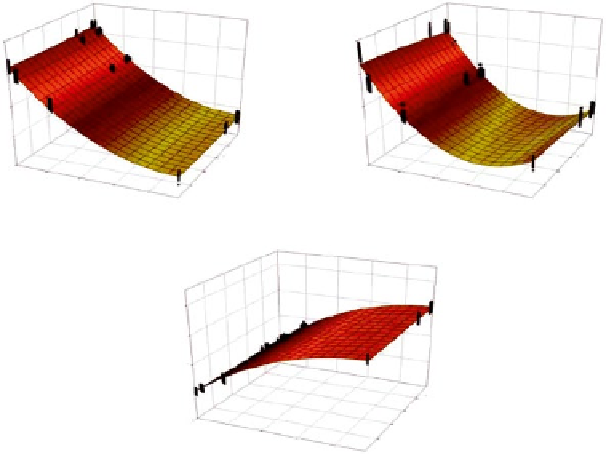Agriculture Reference
In-Depth Information
v = -14.5 - 0.21 P - 5.30 N + 0.14 N
2
v = - 39.1 + 0.45 N - 7.59 P + 0.28 P
2
RMSE = 1.27
r
2
= 0.99
RMSE = 2.16
r
2
= 0.99
-20
0
-20
-40
-60
-80
-100
-40
-60
-80
4
4
8
8
12
16
12
16
4
4
8
8
12
12
16
16
v = -1.48 + 0.01 P +1.78 K - 0.018 K
2
+60
+40
+20
0
-20
4
RMSE = 1.16
r
2
= 0.99
8
12
16
10
20
30
40
Fig. 9.9
Simultaneous sensing of ions from nitrate, from plant available phosphate and from plant
available potassium by an electrochemical cell with ion-selective electrodes in a laboratory. For
each graph, the respective primary ion that is to be sensed is on the front axis along the bottom.
And the interfering ion is on the respective right axis of the bottom (From Kim
2006
, altered)
Summing up: within the near future, the best prospects in practical applications
probably exist for on-the-go soil water pH sensing. The reason for this is not only
the fact that this can be done using naturally moist soil and that - contrary to sensing
of nitrate - no technique for the creation of a slurry is needed. An additional fact is
that recording of the soil water pH is
temporally
simpler than the sensing of nitrate
by ion-selective electrodes. Because the soil pH hardly changes over months, but
the nitrate content can vary within some days. And the more short-termed the situa-
tion is, the more a control system is needed that operates in real-time. Consequently,
for the application of nitrogen, a real-time control system is much more important
than for the spreading of lime. Yet none of the present sensing systems that use ion-
selective electrodes allow real-time control because of the time intervals between
the signals.
As for potash and phosphates, the former nutrient is easier to sense by ion-
selective electrodes than the latter. However, the site-specific situation for phos-
phates can - after some preparations - very well be mapped via sensing of the
nutrient removal by the previous crop (Sect.
9.1
). On soils with clay the same
might hold for potash. So it is be reasonable not to use the same sensing method
for all nutrients.

